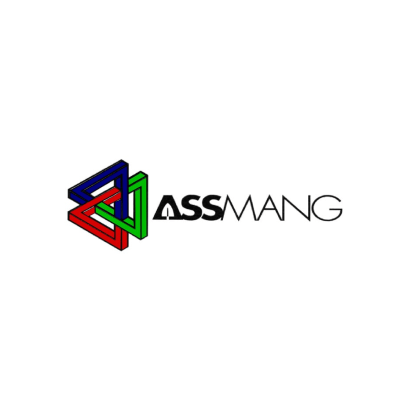The Khumani mine project was to be implemented in two phases:
- Phase 1 was to be completed in September 2008 and would have a capacity of 8.4 million tons of iron ore per year. Phase 1a, to be completed in December 2008, would have a capacity of 10 million tons per year.
- Phase 2 will have an annual production level of 16 million tons and is scheduled for completion in late 2010 / early 2011.
- A possible further expansion to 22 million tons per annum is presently at the feasibility study stage.
The iron ore is mined from a series of open pits by conventional drilling and blasting before being loaded onto trucks for hauling to the primary and secondary crushers. From there, the ore is transferred by conveyor to stockpiles ahead of the beneficiation plant. The run-of-mine ore is stockpiled on blending beds in two categories, ‘on-grade’ and ‘off-grade’.
The on-grade ore is crushed, washed and graded according to four size categories. The off-grade ore goes through an identical crushing, washing and screening process, followed by a jig beneficiation plant to match its chemical composition with client specifications.
There are 8 Geoscan on-line analysers installed at critical locations in the plant to monitor the chemical composition of the ore in real-time, so that immediate remedial action can be taken if the ore deviates from the chemical grade requirements.
Products are stockpiled ahead of a rapid load-out station, which has the capability to load 342 x 100-ton wagons in 8 hours – that’s one 100-ton wagon every 90 seconds. From there, the product is railed 860 kms to the port of Saldanha Bay for export.
Solution selection
DRA Mineral Projects were appointed as the Managing contractor for this project and EPCM contractor for the plant and infrastructure. DRA Mineral Projects is an engineering company that specialises in project management, engineering design and implementation and has implemented successful projects on five continents. DRA appointed system integrator Iritron for the ArchestrA System Platform 3.0 implementation portion of the project. Iritron was actively involved in the systems engineering, instrumentation design and PLC control systems aspects of the scheme.
This was a natural choice since African Rainbow Minerals and ASSMANG have standardised on AVEVA (formerly Wonderware) industrial automation solutions for all their SCADA, Historian and plant web portal requirements, and Iritron is an ArchestrA-certified system integrator that has provided AVEVA solutions and support to ASSMANG since 1999.
“To effectively monitor this huge complex, we implemented AVEVA System Platform which is based on ArchestrA technology and includes real-time Historian, the Information Server web portal, ActiveFactory real-time production performance analysis and reporting software and InTouch for the SCADA/HMI applications serving some 44 000 I/O tags,” says Iritron director Johann Pienaar. “In addition, we used the Topserver I/O Servers from Software Toolbox to communicate between the PLCs and the System Platform as well as MDT Software’s AutoSave for the change control management of all 63 Allen-Bradley ControlLogix PLCs.”
“These solutions were chosen to give us comprehensive data analysis facilities so that we could check production status and identify potential problems at any time, “ says Marius Malan, control systems supervisor, ASSMANG. “We also need continuous operation without loss of control or data as well as web access facilities and links to our planning and ERP systems. Most importantly, it all has to work through a user-friendly and intuitive operator interface.
“But these are all things we need to do now. This is a brand-new mine with a long future and we will need to adapt production to meet with market demands. That means we’ll have to expand the system as and when required and we’ll also have to do it quickly and at minimal cost.”
System implementation
Allowing for the expansion of systems at minimal cost is a cornerstone of ArchestrA technology and one of the ways this happens is through the development of standards.
Standards allow companies to define, apply and enforce their engineering criteria so that everyone works from the same page. Standards also mean that plant objects are built from templates and that changes to a single master template can be propagated to every instance of that object throughout the plant.
“The standards enforced by ArchestrA are allowing us to describe plant objects and their behaviour to reflect our experience and needs,” says Malan. “Being ASSMANG standards, they reflect our best practices and can be used by other companies in the group. The enforcement of standards ensures that all future development conforms to the norms already developed and this will save engineering time in the future, especially with the planned extensions to the plant.”
Standards don’t only apply to plant objects but also to the whole plant and to integration with other disciplines in the company. One of the key standards that helps businesses build a coherent organisation is ISA-95.
“Khumani’s plant model is based on the ISA-95 standard which was facilitated by AVEVA’s System Platform Application Server and its best practices guide supplied by IS³,” adds Pienaar. “This standard was implemented and adhered to throughout the project and will greatly facilitate integrating the system’s information with ASSMANG’s planning and ERP systems.”
Another important ArchestrA attribute that safeguards expansion at minimal cost is that of scalability. At Khumani, they know they will have to double their capacity in two years and, in ordinary conditions, this could mean some expensive system rework.
“When the time comes to expand the system, the initial work done on standards means that defining new capability will be a matter of hours rather than weeks or months,” says Pienaar. “In addition, ArchestrA has been proved to handle more than a million I/O tags and we’re currently looking at (only) about 44 000. This, together with a self-configuring historian, makes system expansion painless.”
ASSMANG’s Khumani mine, a major contributor to the company’s financial well-being, can’t afford unplanned production delays during its lengthy and productive life. The mine has to produce quality products that will be accepted worldwide in an extremely competitive market and to do that, it needs industrial information and automation equipment equal to the task.
“ArchestrA’s management of dual redundancy procedures not only guarantees delivery of data to the Historian but has saved us a significant amount of complex software engineering to resolve this critical issue, says Malan. “In fact, we no longer think “redundancy” but rather of decisions that have to be made given the wealth of available information – in other words, forget the technology and focus on the business.”
Apart from standards, scalability and system availability, ASSMANG needs a few more key attributes from a system in charge of one of its primary wealth-creating facilities and these are security and architectural freedom – which don’t mean much if said quickly but are key to versatility and freedom of choice.
“In a situation such as ours, it’s important that only authorised personnel has access to various levels of the system to make changes to set points and other parameters,” says Malan. With the System Platform, security and alarming are uniform across the entire system and we don’t have to make provision for discrete sub-systems. Of equal importance is our ability to change our mind with respect to the structure of our system and its interaction with others. ArchestrA technology gives us that choice. For example, we had to integrate with a number of third party stand-alone InTouch applications incorporated into the Metso crushers, the Bateman load-out station, a QMastor stockpile management system and a CCLAS LIMS system. Well, it all just ‘happened’”.
Conclusion
“For us, the most significant aspect of this project was that ArchestrA technology gave us a multi-user development environment that allowed us to design, develop, implement and maintain a large project in one year,” says Pienaar. “ArchestrA’s integrated development environment gave us the tools to develop complex applications without bothering unnecessarily about the details of interfacing with PLCs at one end of the spectrum and ERP systems at the other while providing the functionality to do both.”
From the start, ASSMANG’s Khumani mine is a winner, not only in terms of its rich deposits but also in terms of how it will process them. Today, no enterprise can survive without efficiency and a major contributor is how well processes can be measured and controlled. AVEVA’s System Platform will be providing Khumani mine’s managers and operators the plant intelligence they need for efficient operation far into the future.









